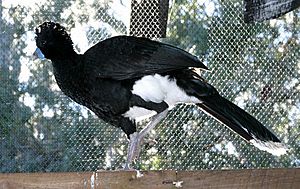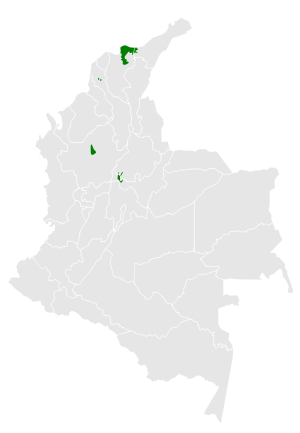Blue-billed curassow facts for kids
Quick facts for kids Blue-billed curassow |
|
|---|---|
 |
|
| Male | |
| Conservation status | |
| Scientific classification | |
| Genus: |
Crax
|
| Species: |
alberti
|
 |
|
| Distribution of the blue-billed curassow | |
The blue-billed curassow (Crax alberti) is a species of bird in the family Cracidae, the chachalacas, guans, and curassows. It is endemic to Colombia.
Contents
Taxonomy and systematics
The blue-billed curassow is monotypic. However, it formerly included what is now the yellow-knobbed curassow (Crax daubentoni) as a subspecies. The holotype of putative species C. annulata has been determined to be a female blue-billed curassow.
Description
The blue-billed curassow is 82.5 to 92.5 cm (2.7 to 3.0 ft) long and weighs 3.2 to 3.6 kg (7.1 to 7.9 lb). It is the only curassow with a blue cere and wattle, the latter found only on the male. Males are mostly black with a white vent and tail tip. Females are also mostly black but their lower belly and vent are rufous. They have fine white barring on the wings and tail, and a rare "barred" morph also has barring on the breast and belly. Both sexes have a crest, the male's black and the female's black and white.
Distribution and habitat
The blue-billed curassow is found only in northern Colombia. It has a highly fragmented range, with small populations between La Guajira and Magdalena Departments south to Antioquia and Boyacá Departments. It inhabits undisturbed forest in the tropical and upper tropical zones, mostly from near sea level to 600 m (2,000 ft) but at least formerly as high as 1,200 m (3,900 ft).
Behavior
Feeding
The blue-billed curassow mainly feeds on the ground. Its diet has not been extensively studied but it is known to include fruits, worms, and insects. It also takes in sand and small stones as digestive aids.
Breeding
The blue-billed curassow's breeding season spans from December to at least April. It is reported to be monogamous. It builds a large nest of sticks and dead leaves and conceals it in dense vine tangles. It typically places it between the understory and the subcanopy. The clutch size is two eggs.
Vocalization
Male blue-billed curassows "boom" from the ground, "a 4–5-syllable series of deep notes...repeated over and over, 'hmm...hmh...hmm...hmm...hmh'". Both sexes give an alarm call, a "soft, high-pitched whistle 'peh-weeeéoh' or 'pehoo'".
Status
The IUCN has assessed the blue-billed curassow as Critically Endangered. Its population is estimated to be fewer than 1,500 mature individuals and its population is fragmented and decreasing. Deforestation and hunting are the major threats. The ProAves El Paujil Bird Reserve in Santander Department was created in 2003 especially to protect one population. Captive breeding has been successful.
See also
 In Spanish: Paujil colombiano para niños
In Spanish: Paujil colombiano para niños


